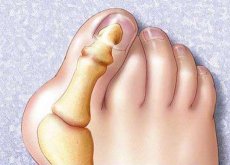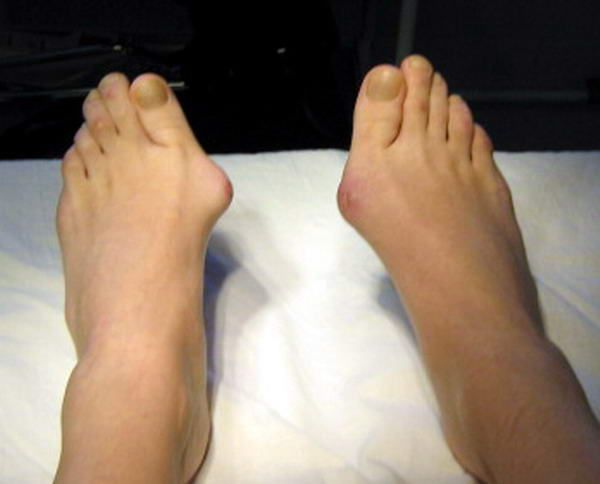Medical expert of the article
New publications
How to get rid of bumps on your feet?
Last reviewed: 05.07.2025

All iLive content is medically reviewed or fact checked to ensure as much factual accuracy as possible.
We have strict sourcing guidelines and only link to reputable media sites, academic research institutions and, whenever possible, medically peer reviewed studies. Note that the numbers in parentheses ([1], [2], etc.) are clickable links to these studies.
If you feel that any of our content is inaccurate, out-of-date, or otherwise questionable, please select it and press Ctrl + Enter.

Bunions are the cause of pain, discomfort when wearing shoes and unsightly appearance of the feet. Why do bunions appear on the feet and how to get rid of them?
 [ 1 ]
[ 1 ]
Why do bones appear on the feet?
Bunions are an unpleasant, unsightly addition to flat feet. Bunions appear because the big toe is deformed as a result of improperly worn shoes (too tight), unwise nutrition, hereditary and acquired diseases. Then the bone on the foot becomes inflamed, deformed and begins to stick out. It becomes similar to a small lump under the skin. It is called hallux valgus.
A bunion appears due to deformation of the foot and toe as a result of flat feet. It develops due to extremely weakened ligaments of the foot. The more often a person wears tight shoes, the more the bunion develops, which increases the load on the foot and toe. If a person also moves a lot or stands on their feet a lot, without giving them a break, the problem with the bunion gets worse.
Bunions can be confused with other diseases, such as gout. To confirm the diagnosis, you need to see a doctor for examinations.
At-risk groups
Of course, women. For every ten women suffering from bunions, there is only one man. The reasons that bunions affect women more often are hormonal imbalances during menstruation, menopause, and a love of beautiful but tight shoes.
Women over 40 are most at risk of getting bunions, when many of the body's functions begin to decline, although in rare cases this disease develops in adolescence.
Stages of development of bones on the feet
The stages of development of bunions depend on how deformed the big toe is. Doctors determine the degree of its curvature using X-rays.
- The first degree of finger displacement is less than 20 degrees, there is no pain, the curvature is visible to the naked eye
- The second degree of finger displacement is from 20 to 30 degrees, there is pain, but it is mild and quickly passes, the pain can intensify with prolonged stress on the legs
- The third degree of finger displacement is from 30 to 50 degrees, severe pain occurs at the site of friction and contact with shoes, the joint freezes in one position. Pain mainly occurs when a person walks or stands on his feet for a very long time.
- The fourth degree of toe displacement is more than 50 degrees. The pain is significant, it occurs not only during movement, but also when the foot is at rest. In addition to the bone on the foot, calluses, compaction in the joints also occur, the bones gradually grow, inflammation occurs in the joints. This is very painful, requires painkillers and surgical intervention.
Diagnostics
Bunions may be associated with arthritis, gout and other joint diseases. Diagnostic tests include X-rays, visual examination by an orthopedic surgeon and surgeon, and consultation with a traumatologist.

It is important to correctly diagnose hallux valgus, distinguishing it from other joint diseases. Then you can choose the best way to treat the bunion. In most cases, surgical intervention is required.
Treatment methods for bunions on the feet
There are several of them, and these methods usually work effectively in combination, rather than individually.
Diet therapy
If a person develops bunions, he should exclude from the menu all dishes that can cause the risk of developing joint inflammation and irritate it. These are fried, spicy, meat, broths with spices, beans, flour products with a lot of cream. Vitamins C, E, A are also needed.
 [ 16 ]
[ 16 ]
Comfortable shoes
Those who have developed bunions should use only comfortable shoes made of genuine leather. Shoes with heels and narrow toes, as well as too tight models are excluded - this puts additional stress on the foot and especially on the sore joint, muscles and ligaments of the deformed foot.
Heels are allowed, but not more than 4 cm. If you wear socks, they should be made of natural fabric, this will allow the foot to breathe and not be constrained.
Exercises for treatment
These exercises are very simple, but they are very good for preventing and reducing bunions.
- Walk barefoot, it will strengthen your feet.
- Throw a pencil on the floor and pick it up with your toes. Then, with the pencil in your toes, draw numbers from 1 to 5 with your foot. This will make your joints more flexible and less prone to inflammation.
- Grab the fabric with your feet and crumple it, then lift it off the ground. Throw the fabric on the ground and straighten it with your toes without bending. This will exercise your joints and make them flexible. It is also a great prevention of bunions.
 [ 19 ]
[ 19 ]
Foot massage
This is also a great remedy for bone spurs. Foot massage restores blood flow and activates the receipt of useful substances with it. It also relaxes muscles, relieves tension from them, as well as from ligaments and tendons.
Physiotherapy
Hallux valgus can be removed through physiotherapy. Treatment with mud, ultrasound, baths and electrophoresis will help your feet relax, improve blood flow, and nourish your leg muscles with useful substances. An orthopedic doctor will suggest the best treatment.
 [ 20 ]
[ 20 ]
Anti-inflammatory medications
To remove the inflammatory process and reduce pain, the doctor prescribes anti-inflammatory drugs. These include tablets, ointments, creams, patches, gels, injections.
Anti-inflammatory drugs are used to relieve pain in the bones; some of them are applied locally to the area of pain.
 [ 21 ], [ 22 ], [ 23 ], [ 24 ]
[ 21 ], [ 22 ], [ 23 ], [ 24 ]
Surgical intervention
Bunions can also be treated by surgery. However, “treat” is not quite the right term. The bunions are removed, followed by a rehabilitation process, and then the person can wear narrower shoes – the bunions no longer interfere with walking.
The operation is also needed to restore the shape of the crooked fingers and fix them in the desired position.
After the operation, the doctor removes the stitches on the 4th-5th day. Two weeks are enough to recover from the operation.
To prevent the pain and inflammation from returning, and to prevent the toes from being deformed, heels higher than 4 cm should not be worn for up to a year. A year after the operation, the height of the heels can be increased by only 2 cm, but not more, so as not to cause a relapse.
 [ 25 ], [ 26 ], [ 27 ], [ 28 ]
[ 25 ], [ 26 ], [ 27 ], [ 28 ]
When is it not possible to have bunion surgery?
If a person is obese, has poor blood clotting, diabetes, varicose veins, cardiovascular diseases, or thrombophlebitis, it is better not to perform bone surgery to avoid negative consequences for the body.
Non-surgical method of correcting bunions on the feet
One of these methods can be orthopedic splints. They correct the position of the joint and fix it in the correct position. If you wear such a splint for a long time (prescribed by the doctor), the foot is restored to its normal position.
Such splints are also called valgus splints – after the name of the disease they eliminate. This splint is used both at the initial stages of the development of the bone on the legs, and at the stage when the valgus deformation of the foot has gone far. Valgus splints are also used after the operation – for better fixation of the foot in the correct position.
The splint is usually placed on the big toe and fixes it in the correct position. This reduces the risk of arthrosis, joint inflammation, and deformation. The splint can be used on both legs and for feet of any size. Such a splint does not interfere with walking and can be worn for a long time. However, at first the splint is worn for an hour or two, then removed to allow the foot to rest. Then the time of wearing the splint is increased. It can even be left on overnight - this will not harm the foot.
A good effect is achieved by gradual but long-term use of the splint. This happens when a person wears the splint 2-3 hours a day and leaves it on all night, but does so for a month or two. Such regularity will give excellent results.

